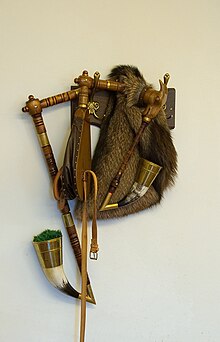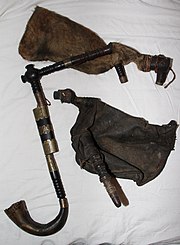Buck (bagpipes)
The buck is a type of bagpipe that was widespread in parts of Central Europe until the 19th century and is now mainly played in the Czech Republic . Nowadays, air is generally supplied by means of bellows .
description
The buck usually has a drone two octaves below the fundamental . The individually executed drone and the melody pipe have a cylindrical bore and a simple reed for sound generation. Most of the time, the airbag is made of fur or is covered with one, the wind capsule of the melody whistle is designed in the shape of a billy goat head. Nowadays, air is generally supplied by means of bellows , which has the advantage that the player can sing at the same time. Hand-blown rams were played in Bohemia and the neighboring Egerland until the twentieth century.
At the ends of the pipes there are usually upward lintels made of horn and brass . The melody pipe is traditionally diatonic and has a range from the fifth below the root to the sixth above, the sixth below the leading tone is mostly missing, except for the Sorbian and related West Polish goats; it is traditionally always played in major. The drone whistle of the Bohemian buck is attached to the airbag via a right-angled connection, so it protrudes over the player's shoulder. With the Egerland goat, the drone pipe hangs down in front of the player or can be placed on the player's legs while sitting.
The usual tunings today are Eb in Bohemia, F in Bavaria, Austria and the Sorbian country , G and D in Moravia. Most of the Egerland instruments have high tunings from B to high Eb. In the Bohemian buck, the drone usually has a pipe shortener from tuning F and lower.
history
The small bronze bagpiper, cast between 1564 and 1568, who adorns the Singing Fountain in Prague , plays a buck that is astonishingly similar to today's instruments. Until the beginning of the 19th century, the buck was widespread as a folk instrument in Bohemia and existed in a similar form throughout southern Germany, including Austria and the areas bordering on the east. At the beginning of the 20th century it was almost extinct. The South Bohemian Folklore Festival (1955–1961) and the international bagpipe festival in Strakonice (since 1967) led to a revival of the instrument in Bohemia. In the meantime, the goat has also found its place in folk music in southern Germany and Austria .
distribution
- Bucks around 1800
The buck was widespread in parts of Central Europe until the 19th century and is now mainly played in the Czech Republic , especially in South Bohemia . The last bagpipe culture carried by German speakers lasted until the late 1990s in the Bohemian emigrant community of Puhoi in New Zealand and is carried on today by English-speaking New Zealanders. In the course of a revival of the instrument there are again numerous players in Bavaria and Austria .
There are similar bagpipe shapes in Slovakia , Poland , Hungary , Croatia and among the Sorbs in Lusatia
The Czech word for "bagpipes" is dudy (f. Pl .; Old Church Slavonic dud- "blow"), from which the German word bagpipes is derived. Michael Praetorius already performed a bagpipe called the Großer Bock in his Syntagma musicum , which is equipped with the characteristic horns. The name Bock is part of a series of other language names for bagpipe shapes in Europe, all of which refer to the word meaning goat or similar: Koza and Kozioł in Poland, Gaita in Northern Spain, Cabrette and Chabrette in France. This is due to the fact that even today the airbag is usually made from the bellows (i.e. the peeled skin with fur) of a goat or is covered with a goat skin. Another popular material for this was and is dog fur .
literature
- Pavel Cip, Rudolf F. Klapka: Bagpipes in Bohemia, Moravia and Silesia / Dudy v Cechach, na Morave a ve Slezsku. Publishing House of the Minstrels; Salve Regina, 2006. ISBN 3-927240-81-8
- Georg Balling, Walter Deutsch, Ralf Gehler, Armin Griebel, Herbert Grünwald, Ernst E. Schmidt: The bagpipes in Europe - with special emphasis on Bavaria. Bayerischer Landesverein für Heimatpflege, Munich 1996, ISBN 3-931754-02-2 .
Individual evidence
- ↑ Togetherness. The 1901 Triple Wedding. (No longer available online.) In: History of Puhoi. Puhoi Historical Society Inc, archived from the original on February 5, 2013 ; accessed on June 22, 2012 (English).
- ↑ Joseph Režný: The Sorbian bagpipes. House for Sorbian Folk Culture Bautzen, Sorbian Folklore Center. 1993





